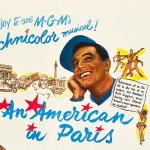 MGM’s Freed Unit, which began creating musical films in 1939 under producer Arthur Freed’s leadership, reached the peak of its creative and critical acclaim in 1951 with An American in Paris, which won the Oscar for Best Picture. Much of the film’s fame rests on the 17-minute ballet finale featuring Leslie Caron and Gene Kelly, who received an honorary Oscar “specifically for his brilliant achievements in the art of choreography on film,” inspired by the 1928 orchestral composition by composer George Gershwin.
MGM’s Freed Unit, which began creating musical films in 1939 under producer Arthur Freed’s leadership, reached the peak of its creative and critical acclaim in 1951 with An American in Paris, which won the Oscar for Best Picture. Much of the film’s fame rests on the 17-minute ballet finale featuring Leslie Caron and Gene Kelly, who received an honorary Oscar “specifically for his brilliant achievements in the art of choreography on film,” inspired by the 1928 orchestral composition by composer George Gershwin.
In 1949, lyricist Ira Gershwin had sold producer Freed rights to the Gershwin Brothers musical catalog, which included such standards as “I Got Rhythm,” “Love Is Here to Stay,” “I’ll Build a Stairway to Paradise,” and “’S Wonderful.” Freed hired Alan Jay Lerner to write a screenplay that used as many of those songs as possible and asked Ira to consider writing new lyrics for “certain unpublished George Gershwin music.” Lerner submitted his first draft on June 12, 1950, which is much the same as the final shooting script. Ira did not submit new songs.
The story centers around Jerry (Kelly), who has moved to Paris after WW2 to find fame as a painter. Very soon he meets Lise (Leslie Caron), whom Henri (Georges Guétary) has been dating. Milo (Nina Foch) takes an interest in Jerry’s art and in him, but he is smitten with Lise, who decides to marry Henri. As Lise and Henri leave for their wedding, Jerry daydreams about dancing around the city with Lise, to the tune of “An American in Paris.” He is woken from his reverie to find that Lise has returned to him. They embrace as the song (and film) ends.
The “American in Paris” dream ballet finale cost nearly half a million dollars and was filmed on 44 sets. Kelly and director Vicente Minnelli had submitted the final outline of their idea to Freed on Sep. 6, 1950: “Each individual scene will be done in the styles of different painters,” they wrote. “In essence, the entire ballet is a representation of a painter thinking about Paris.” The painters chosen were Dufy, Renoir, Utrillo, Rousseau, van Gogh, and Toulouse-Lautrec.
Most of the elaborate film was shot on MGM’s Culver City lot, but some location filming was done in Paris. However, the only Parisian footage used was the opening montage, some establishing shots of French landmarks, a tracking shot of Milo driving to her hotel, and a few atmospheric backgrounds.
The gala premiere was held in Los Angeles on Nov. 9, 1951, and the film opened to excellent reviews, earning $7 million its initial theatrical release. New York Times critic Bosley Crowther gave a mostly positive review, largely on the strength of the ballet, which he called “one of the finest ever put upon the screen.” Variety thought it was “one of the most imaginative musical confections turned out by Hollywood in years,” and Washington Post critic Richard L. Coe called it “the best musical movie I’ve ever seen.”
The film received eight Oscar nominations and won six, including picture (Freed), screenplay (Lerner), art direction, cinematography, costume design, and scoring.
In 1993, it was selected for preservation in Library of Congress National Film Registry, and it ranked #9 on AFI’s Greatest Movie Musicals list. The song “I Got Rhythm” (watch here) ranked #32 on AFI’s 100 Songs list.
In 2014, a stage adaptation premiered in Paris, starring Robert Fairchild (Jerry) and Leanne Cope (Lise), with a script by Craig Lucas directed and choreographed by Christopher Wheeldon. It transferred to Broadway in 2015.
Listen to the soundtrack, then rent or purchase the film through Amazon Prime. TCM regularly broadcasts the film, and it will next on July 4 at 6 a.m. ET. For more on the making of the film, read the 2015 BFI Film Classics book on An American in Paris by Sue Harris.
NEXT, explore Funny Face (1957), which centers around a photographer (Fred Astaire) who falls for model Jo (Audrey Hepburn) in Paris, underscored by Gershwin songs. It’s Astaire’s American in Paris, featuring several Freed Unit members from MGM on loan to Paramount, including Roger Edens, Stanley Donen, Kay Thompson, and Astaire himself. The highlight is the final song, “’S Wonderful” (watch here).
THEN, look for Summer Stock (1950), another Freed Unit musical film with Kelly and Judy Garland, her final film for MGM. TCM will broadcast the film next on June 10 at 10 a.m. ET. The film’s most famous scene is the iconic closing number “Get Happy” (watch here) by Harold Arlen and Ted Koehler, sung by Garland in a tuxedo jacket, fedora, and nylons.
